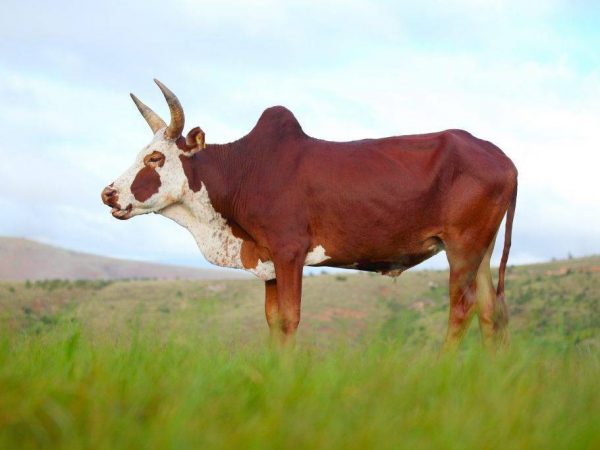Cow Zebu
Zebu belongs to wild bulls, being one of their subspecies. He occupies a special position among the representatives of cattle.

Cow Zebu
About bulls zebu
The wild zebu bulls, in comparison with the common European cow, do not descend from the cloven-hoofed tur, which is the progenitor of many modern cattle. Zebu is its offshoot, which broke away from the primitive wild bulls of the rounds about 300 thousand years ago.
Zebu are less perfect for agricultural use than European cattle, because they have not been improved in the breeding process.
Since the twentieth century, the Zebu cow began to interbreed with Europeans. Such mating has resulted in increased endurance, resistance to high temperatures and resistance to various tropical diseases in the resulting generations.
A purebred animal, in comparison with European cows, gains body weight and grows rather slowly, while giving out less dairy products.
External features
From the photo of a zebu cow, it is immediately noticeable that there are characteristic distinctive features in its appearance, the description of which distinguishes this cattle from European representatives:
- the main feature is a large hump located on the nape of the animal, which can be covered with wool at the edges,
- Another distinctive feature of the zebu is the skin folds that have developed in the area between the forelimbs.
The photos show how peculiar the zebu look. The formation of a hump in them is associated with two specially developed types of muscles: trapezius and rhomboid, which over a long period of time are able to strongly germinate with a fat layer and be reborn. The hump for these animals serves as a fat-forming component.
In addition, in the photo of zebu animals, it is noteworthy that they differ from other cattle in their strong constitution, the zebu pictures also reflect this moment. They have a narrow, elongated head with a convex frontal part with drooping ears. Some breeds differ in the size and shape of the horns. For example, the Somali zebu wears swinging horns on its head.
Animals can be of different colors: from light gray and black to red and variegated.
Habitat
Zebu are distributed mainly in Indian territory. The climatic conditions of the tropics and subtropics are best suited for their residence. Today, out of 70 breeds that exist in the world, many can be seen on the island of Madagascar. On the island, the zebu-shaped cow enjoys special honor, representing one of the symbols of the state, and belongs to the sacred, although its meat is eaten and sacrificed in religious rituals. There are more animals in Madagascar than people live there.
On the African continent, there are several breeds obtained by crossing zebu with European cows.
Who gave the world this livestock? This country is considered to be Indonesia.The Indonesian-born zebu cow was introduced to the African continent several hundred years ago and became an object used in ritual ceremonies. In addition, animals live on the territory of Azerbaijan, a small population is also represented in Brazil. Zebu can be seen on Turkish and Iranian farmers, in China and Korea. The animal widespread in Central Asia is sometimes called the "Asian zebu".
Productivity and living
The average weight of cows is 0.25 tons, bulls - 0.150 tons. Dairy indicators in these animals are low: they are capable of producing up to 0.6 tons of milk for the annual lactation period with a fat content of 5.2-5.8%. Enhanced fattening and compliance with good keeping conditions increase the average annual milk yield from 2.0 to 2.5 thousand kg of milk with a fat content of 5.5%.
In Uzbekistan, the Kurom species, belonging to the small size of the variety, has established itself as a source of high-quality dairy products with fat content reaching 8%.
In conditions of a proper diet, a zebu-like animal shows high weight gains, providing medium-quality meat products, the slaughter yield of which is 40-45%. The skin of adult animals serves as a source of material for the manufacture of shoe soles.
In places of residence, animals have established themselves as helpers for humans in agriculture and everyday life. Easily acclimatized, they are immune to various diseases that adversely affect young animals, therefore they act as producers for crossing with cattle of other breeds.


